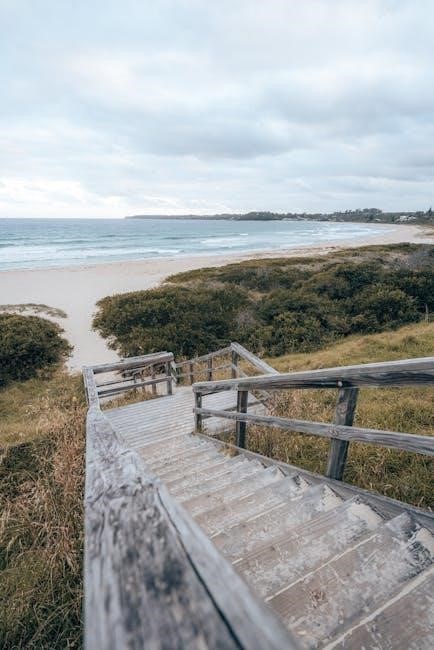Welcome to the enchanting world of watercolor painting! This versatile medium offers endless opportunities for creative expression, making it perfect for both beginners and experienced artists. Whether you’re looking to explore your artistic side or simply unwind, watercolor painting provides a therapeutic escape and a chance to bring your imagination to life. Dive in, and let’s begin your artistic journey with this step-by-step guide!
1.1 Overview of Watercolor Medium
Watercolor painting is a translucent and fluid medium that involves blending pigments with water to create vibrant, layered artworks. Known for its unpredictability, watercolor allows for delicate washes and intricate details. It’s a popular choice for capturing soft textures and ethereal effects. The medium’s versatility makes it ideal for both loose, expressive pieces and highly detailed compositions, offering endless creative possibilities for artists of all skill levels.
1.2 Benefits of Learning Watercolor
Learning watercolor offers a world of creative rewards! It fosters mindfulness and relaxation, as the fluid medium encourages patience and spontaneity. Watercolor painting is also an excellent way to develop fine motor skills and attention to detail. Plus, it’s an accessible art form, requiring minimal supplies to get started. Mastering watercolor builds confidence and opens doors to endless artistic expression, making it a fulfilling journey for all levels.

Essential Materials and Setup
Gather your brushes, paints, and paper to begin your watercolor journey. A sturdy palette, water container, and tape are also must-haves for a smooth creative process.
2.1 Must-Have Supplies for Beginners
Start with high-quality watercolor paints, a variety of round and flat brushes, cold-pressed paper, a sturdy palette, a water container, and masking tape; These essentials ensure a smooth start to your artistic journey, allowing you to explore techniques and creativity with confidence.Invest in these basics to lay a solid foundation for mastering watercolor painting step by step.

2.2 Preparing Your Workspace
Set up your workspace by taping your watercolor paper to a clean, flat surface. Organize your paints, brushes, and water containers within easy reach. Keep paper towels and a mixing palette handy. Ensure good lighting and a comfortable seating arrangement. Optional: Place a sketch or reference image nearby. A well-prepared workspace fosters creativity and efficiency, helping you focus on your artistic process without distractions.

Understanding Color Theory Basics
Understanding color theory basics is essential for mastering watercolor. Learn the fundamentals of color harmony, the color wheel, and how primary and secondary colors mix to create stunning palettes.
3.1 Primary and Secondary Colors
Primary colors—red, yellow, and blue—are the foundation of color theory. They cannot be created by mixing other colors. Secondary colors, including orange, green, and violet, are formed by combining two primary colors. Understanding these basics enhances your ability to mix vibrant hues and create harmonious palettes in watercolor painting.
3.2 Mixing Colors and Creating Palettes
Mixing colors is a fundamental skill in watercolor painting. By combining primary and secondary colors, you can create a wide range of hues. Warm colors like orange and red evoke energy, while cool colors like blue and green create calm. Experiment with ratios to craft unique shades and build harmonious palettes. Remember, lighter mixes work best for soft blends, while darker tones add depth to your artwork.
Basic Watercolor Techniques
Exploring basic watercolor techniques opens up a world of creative possibilities. Mastering washes, wet-on-wet, and wet-on-dry methods will help you achieve stunning, layered effects. Practice these fundamentals to unlock your artistic potential!
4.1 Washes and Layering
Mastering washes and layering is essential for watercolor painting. Start with light washes to establish the base tone, allowing each layer to dry before adding more. This technique enhances transparency and depth, creating a luminous effect. Gradually build up layers for details, ensuring vibrant colors and crisp edges. Practice this fundamental process to achieve professional-looking results and bring your artwork to life with elegance and precision.
4.2 Wet-on-Wet vs. Wet-on-Dry
Wet-on-wet involves adding wet paint to wet paper, creating soft, blended edges and subtle transitions. Wet-on-dry applies wet paint to dry paper, producing crisp, defined edges. Understanding these techniques helps control blending and detail; Wet-on-wet is ideal for skies and backgrounds, while wet-on-dry suits fine details and sharp lines. Mastering both enhances your ability to achieve desired effects in watercolor painting with precision and artistry.
Sketching and Composition
Sketching is the foundation of watercolor painting, ensuring balance and composition. It helps plan placement and visual appeal, guiding the viewer’s eye through your artwork effectively.
5.1 Transferring Your Sketch
Transferring your sketch onto watercolor paper is a crucial step. Use a graphite pencil for clear outlines, or a tracing method with a light source. Ensure accuracy by double-checking proportions and details. If using a pen, opt for waterproof ink to prevent bleeding. This step sets the stage for a well-composed and balanced painting, allowing you to stay focused on color and technique next.
5.2 Understanding Composition
Composition is the backbone of a successful watercolor painting, ensuring balance and harmony. Use the rule of thirds, symmetry, or leading lines to guide the viewer’s eye. Experiment with negative space to create breathing room. A well-planned composition enhances storytelling and engagement, making your artwork visually appealing and impactful. Practice these principles to elevate your paintings and captivate your audience effortlessly.
Step-by-Step Tutorial: Painting a Simple Landscape
Start by taping your paper, then sketch your composition. Paint the sky and background first, followed by midground elements, and finally add detailed foreground touches for depth and realism.
6.1 Sketching Your Composition
Begin by taping your paper to prevent movement. Lightly sketch your composition with a pencil, using a template or freehand for accuracy. Ensure proportions and balance by dividing the paper into sections. Plan the placement of key elements like the horizon line, trees, and focal points. This step sets the foundation for your painting, guiding the placement of colors and details seamlessly.
6.2 Painting the Sky and Background
Start by wetting the entire sky area with clean water, then apply light washes of cerulean blue or azure for a soft gradient. Use wet-on-wet technique to blend colors seamlessly. For clouds, dab with a damp brush to lift pigment, creating soft, white spaces. Gradually build depth by adding darker shades to the background, ensuring the sky remains the lightest area. Mix colors on the palette to achieve harmonious tones.
6.3 Adding Midground and Foreground Details
Enhance your painting by adding midground elements like trees, hills, or buildings using slightly darker shades. For the foreground, define details such as grass, rocks, or flowers with fine brushes. Use wet-on-dry technique for crisp lines and textures. Mix deeper colors to create dimension, blending edges softly for a natural look. Pay attention to balance, ensuring details don’t overpower the composition.

Common Mistakes and Troubleshooting
Common mistakes include overworking the paint and using dirty water, leading to muddy colors. Fixing mistakes involves lifting excess pigment with a damp brush or starting over.
7.1 Avoiding Overworking the Paint
Avoid overworking by recognizing when a piece is complete. Start with light layers, allowing each to dry before adding more. Clean brushes frequently to prevent muddy colors. Knowing when to stop is key to maintaining freshness and spontaneity in your work. Overworking can lead to dull, lifeless results, so practice self-control and trust the process.
7.2 Fixing Mistakes and Learning from Them

Mistakes are an inevitable part of the learning process. If you accidentally add too much pigment, blot it gently with a clean, damp brush. For larger errors, let the paint dry completely before carefully lifting it off with a wet brush. Embrace these moments as opportunities to refine your technique and understand the medium better. Every mistake brings you closer to mastering watercolor!

Resources for Further Learning
Explore tutorials on platforms like YouTube and Artsydee, offering step-by-step guides and expert tips. Books and online courses provide in-depth lessons to enhance your watercolor skills.
8.1 Recommended Tutorials and Videos
Discover step-by-step watercolor tutorials on YouTube and platforms like Artsydee, featuring expert artists like Emma Jane Lefebvre and Jenna Rainey. These videos cover essential techniques, from basic washes to intricate floral designs. Many tutorials include printable templates and detailed notes, making learning accessible and fun. Subscribe to channels like Matthew White and Kirsty Partridge for consistent inspiration and skill improvement.
8.2 Books and Online Courses

Enhance your watercolor skills with books like “The Art of Watercolor” by Charles Reid and online courses on platforms like Skillshare and Craftsy. Platforms like Artists Network and Udemy offer comprehensive courses covering basics to advanced techniques. Jenna Rainey’s tutorials and Emma Jane Lefebvre’s floral workshops are perfect for structured learning. These resources provide in-depth guidance, helping you master watercolor painting at your own pace.
Congratulations on completing this watercolor journey! Keep practicing, set creative goals, and embrace experimentation. Celebrate progress, learn from mistakes, and enjoy the therapeutic process of painting.
9.1 Encouragement to Keep Practicing

Remember, watercolor painting is a journey, not a destination! Embrace consistency, celebrate small progress, and find joy in the creative process. Each brushstroke is a step forward, teaching you patience and self-expression. Don’t be afraid to experiment—mistakes often lead to beautiful surprises. Set small, achievable goals and reward yourself for each completed piece. Keep exploring, learning, and most importantly, enjoying the therapeutic rhythm of painting. Happy creating!
9.2 Setting Goals for Your Watercolor Journey
Setting clear, achievable goals will help you grow as a watercolor artist. Start with simple projects, like mastering basic techniques or completing a weekly painting. Gradually challenge yourself with more complex subjects, tracking your progress along the way. Celebrate milestones, no matter how small, and stay inspired by exploring new styles or themes. Consistent practice and goal-setting will fuel your artistic growth and keep you motivated on your watercolor journey.
